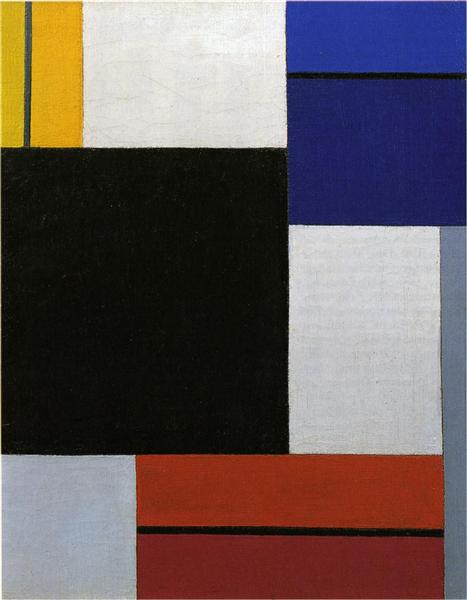Description
The work "Composition XXI" of 1923, conducted by Theo Van Doesburg, is a paradigmatic example of Stijl's movement, of which Van Doesburg was one of the main founders. This painting not only embodies the aesthetic principles of its time, but also reveals the search for a synthesis between art, architecture and modern life. At first glance, the work impacts its carefully organized structure and its exploration of color and shape.
Painting is presented as an assembly of geometric shapes that interact within a two -dimensional framework. Straight lines and color planes are combined to generate a sensation of balance and tension at the same time. Van Doesburg proposed a visual language that seeks to eliminate figurative representation in favor of a purely abstract reality, and "composition XXI" is a testimony of this idea. The absence of recognizable characters or elements allows the viewer to enter an aesthetic experience where the relationships between colors and proportions are predominant.
As for the palette used, the red, blue and yellow primary tones accompanied by blacks and white, which not only provide vigor and dynamism to the work predominate, but are also loaded with symbolism. The use of primary colors was a deliberate choice by Van Doesburg to achieve visual purity that resonated with the idealization of a new and modern society. This approach to chromatic simplification is in line with the philosophy of Stijl, which advocated universal harmony through the reduction to the essential.
The disposition of the forms in "Composition XXI" also deserves to be analyzed. Each segment is delineated with lines that seem to act as borders between the different color blocks. This technique generates a constant dialogue between the planned surface and the space that each form occupies, allowing the viewer to explore the relationship between unity and fragmentation. The geometric structure, with its variations in the scale and proportion, reflects a possible influence of Cubism, although Van Doesburg distanced itself from this current by focusing on pure visual communication through abstraction.
A little commented aspect of the work is its relationship with architecture and design, which are fields that Van Doesburg cultivated and defended with fervor. Composition XXI can be seen not only as a painting, but also as a study on how the principles of functional design can be integrated into art. The similarity can be noted with the ideas of the architect Gerrit Rietveld, who also promoted a functionalist approach and an aesthetic based on structural logic.
When observing "composition XXI", it is observed that the work is a reflection of the artist's ambition to create a new visual language that represents the spirit of his time. In a period characterized by social instability and the search for new identities, this work stands as a manifesto of a new visual order. Van Doesburg advocates a harmony that transcends the individual experience and connects with an ideal of Coesa community through art.
Thus, "Composition XXI" is not only an important work within the trajectory of Theo Van Doesburg, but also stands at the crossroads of abstract painting and contemporary design, inviting the viewer to reflect on the role of art in the art in the Construction of a new aesthetic reality. In its formal simplicity and conceptual complexity, this work becomes a milestone that continues to influence and challenge our perceptions of modern art.
KUADROS ©, a famous paint on your wall.
Hand-made oil painting reproductions, with the quality of professional artists and the distinctive seal of KUADROS ©.
Art reproduction service with satisfaction guarantee. If you are not completely satisfied with the replica of your painting, we refund your money 100%.

